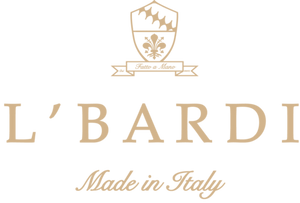The Art Of The Hide
Creating luxury footwear is much like cooking fine cuisine, it all begins with the ingredients, only the finest ingredients will do! One must choose the right hide, for the right application, depending on what type of shoe is being made. Once you source the finest full-grain leathers, only then can you utilise the true artistic skills of the master shoemaker, for a master shoemaker cannot create a masterpiece with poor quality leather, same as fine leather cannot become a masterpiece without the expert hands of the master shoemaker. It is a harmony that L'bardi has made into an art.
The L'bardi Leather
L'bardi only uses the finest full-grain leathers, that are sourced from the finest 'Concerie' or Tanneries within Italy, France and Germany. We typically use calf leather, it is soft, yet durable, breathable and has a beautiful natural grain.
Full-grain leather refers to hides that have not been sanded or buffed to remove imperfections on the surface of the hide. The natural grain remains, retaining the fiber strength and ensuring durability. Since full-grain leather retains the natural grain with all the imperfections of the leather, only the best hides can be used with minimal defects. Hides that have too many imperfections will become corrected-grain, also known as top-grain leathers, in which the grain is heavily sanded to remove the imperfections, it is then stamped with a false grain. This process reduces the thickness of the leather and the overall strength and quality. For this reason, L'bardi only uses full-grain leather. Of the full-grain leathers we source, we use the following types - Full aniline dyed leather, semi aniline dyed leather and crust leather:

Crust Leather
L'bardi has recently started using crust leather for our new sneaker collection and our Limited Edition collection, it is something we will use more and more in all our collections, due to its many fine characteristics. Crust leather is of a neutral beige colour, it is leather that has been treated at tanneries, but not finished with colour/dye. This allows us to hand dye our shoes and create a unique, inimitable patina and depth of colour on each pair of shoes. This technique is known as 'Anticatura' (sometimes referred to as 'Velatura'), it is an italian artform practiced and expertly done by a handful of Italian Calzolai (Shoemakers) and a few French Bottiers (Bootmakers). The handpainted colour gives the shoes an extra volume and a three-dimensional effect created by the contrasting light and shadow of the grain, you can read more about the Anticatura technique here. At L'bardi, we use a combination of hand dyeing the leather before the assembly process, as well as applying the dyes to the finished shoe. Crust leather is notoriously difficult to use, in that only the finest hides in the world can be chosen. With traditional aniline dyed leather the flaws of the leather can be seen immediately, because the colour has already been applied at the tannery, whereas crust leather has to be hand coloured in our workshop, where if there are any flaws, will only be revealed once the hand colouring process begins. For this reason, L'bardi only uses the finest crust leathers in the world, made from the finest full-grain calf leather.

Suede

Calf Hair

Nubuck

